Artificial Intelligence, Machine Learning, and Deep Learning have become popular buzzwords of late.
Part of the reason is the advent of exciting tools such as ChatGPT, Midjourney, and DALL-E that are powered by Artificial Intelligence. Given how powerful and capable AI is, software companies are looking for skilled AI engineers to help them build AI-enabled software for the future.

PyTorch is a skill that any deep learning engineer should have as part of their resume. This course will introduce you to what PyTorch is and point you in the direction of the best learning resources.
What is PyTorch?
PyTorch is a popular machine learning library used with the Python programming language. PyTorch makes it easy for developers to build and train machine learning models quickly and easily.

It was developed by Meta based on the original Torch library made for the Lua programming language. PyTorch is free to use and open-source. As a result, it is a popular choice among developers to build deep learning applications.
Why use PyTorch?
- PyTorch is free and open-source, with a large community to support. It is backed by Meta and is under the Linux Foundation of software.
- PyTorch is easy to use as it has an interface similar to NumPy. This makes it easy to get started if you already know NumPy.
- It is fast. PyTorch supports running operations on a GPU by using the Nvidia CUDA SDK.
- It has a large ecosystem. Because of its popularity, PyTorch has a large number of resources to use to learn to help you. In the next section, you will see our list of the best ones to use.
Online Courses on PyTorch
PyTorch for Deep Learning in 2023: Zero to Mastery
This Udemy course aims to take you from being a Python developer to a full Deep Learning Engineer with 49 hours of video content and 7 articles. This course is probably the most comprehensive you will find on PyTorch that will make you job ready.
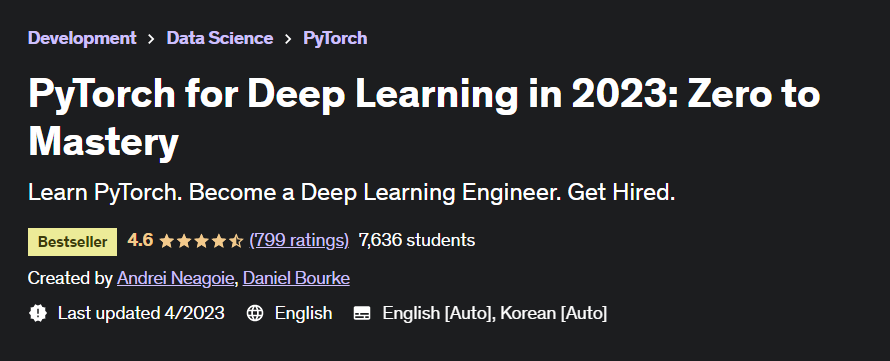
You will begin by covering the basics of PyTorch, such as what a tensor is and what you can achieve with it. Afterward, you will learn the general workflow of building neural network models in Pytorch before building and training models for classification and computer vision problems.
You will also learn how to use custom datasets which you will do as a Deep Learning Engineer building production systems. This course will also teach you some production-level tasks such as transferring learning from existing models, comparing different models’ performance, reading and implementing models from research papers, and deploying your models.
To make the most out of this course, you must already know Python before commencing. In addition, Machine Learning knowledge is recommended though not required.
A Deep Understanding of Deep Learning
This Deep Learning course by Udemy is highly-rated and enrolled. This is in part because it has fewer prerequisites. Instead, you will be taught everything that you need to understand PyTorch and deep learning from scratch.
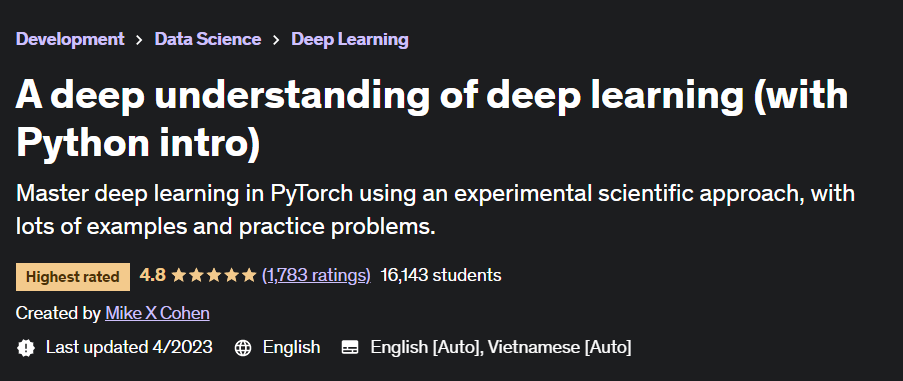
This course starts by giving you a high-level overview of deep learning and how it borrows from concepts in biology by using artificial neural networks. Before going into additional detail, you will be taught the math that underlies and supports deep learning, such as vectors, matrices, and multivariable calculus.
To prepare you further, will learn Python and Numpy. This course also covers the different types of networks you will work with. These include Convolutional Neural Networks, Generative Adversarial Networks, Recurrent Neural Networks, and Feed-Forward Networks.
You will learn how to implement these in PyTorch. As mentioned before, this course requires no prior knowledge before beginning.
PyTorch: Deep Learning and Artificial Intelligence
PyTorch: Deep Learning and Artificial Intelligence will teach you Deep Learning broadly, with a special emphasis on PyTorch. A lot of what you will learn will be in the context of PyTorch.
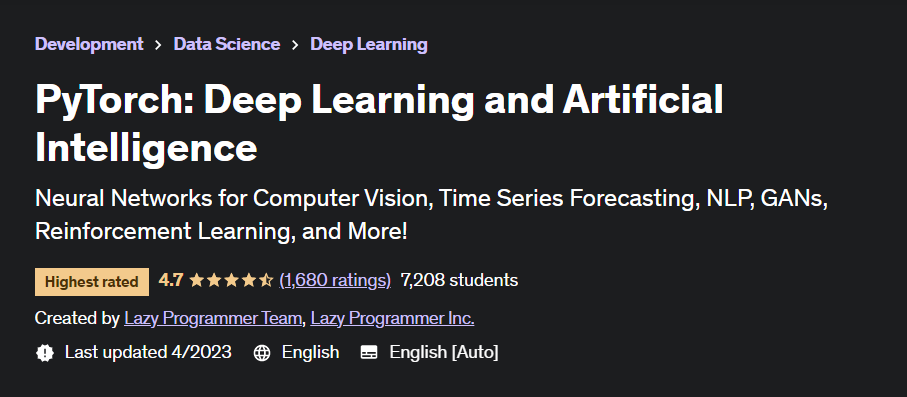
The course begins by introducing you to the basics of machine learning, such as regression, linear classification, and what it means for a model to learn. You will then learn popular network architectures such as Feed-forward Neural Networks, Convolutional Neural Networks, and Recurrent Neural Networks.
In addition, you will learn how to build Natural Language Processing and Recommender systems. You will also learn Computer Vision, Generative Adversarial networks, and Reinforcement learning. Before starting this course, you should already know Python and Numpy. It is also recommended that you know derivatives and probability.
PyTorch Fundamentals
This PyTorch course, offered by Microsoft Learn, is an interactive tutorial written in Notebook style to teach you PyTorch. It includes code examples that you can edit and run to make sure you understand what each line does.
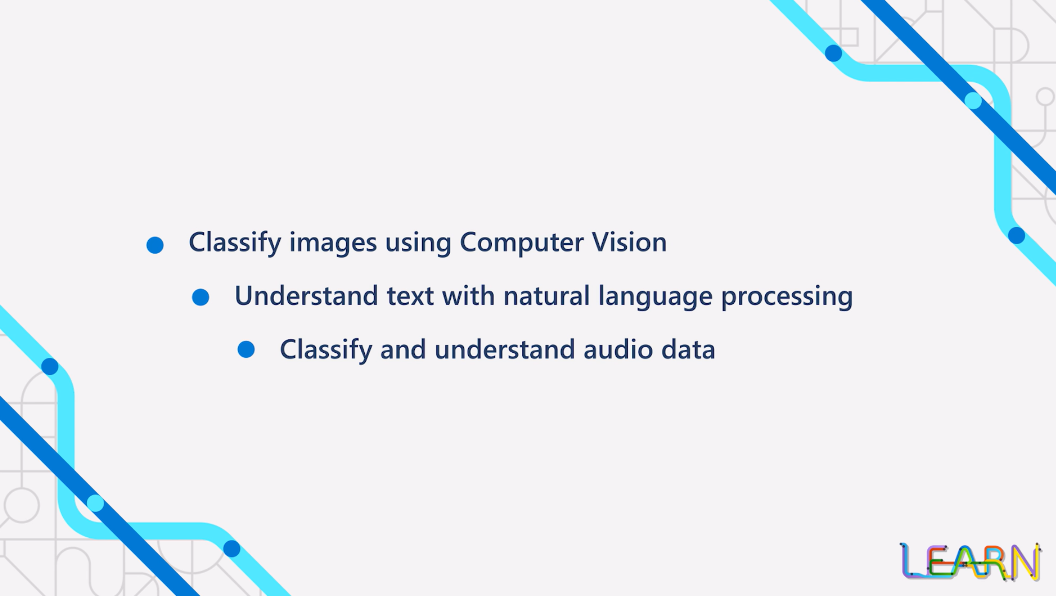
It covers the basics of PyTorch, from the concept of Tensors, how to create them, and why they are useful in PyTorch. You will learn to implement a machine-learning model and train it.
Afterwards, you will learn the full model-building process before specializing in building Computer Vision, Natural Language Processing, and Audio classification applications. Knowledge of Python, Jupyter notebooks, and basic machine learning are the only requirements of this course. The best part about this course is it is free, and you get free compute power to run your exercises in the cloud from Microsoft.
Deep Learning with PyTorch
This Datacamp course is one of the most understandable and well-made courses on deep learning. It is made up of videos to introduce concepts intuitively and interactive exercises to help you practice and solidify concepts.
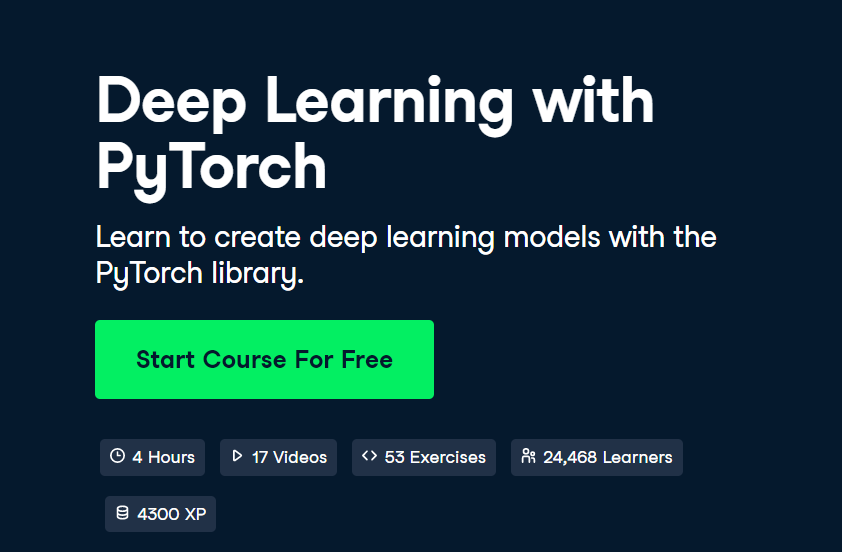
The course begins by introducing you to PyTorch by comparing and contrasting it to Numpy. As a result, familiarity with Numpy helps, and knowledge of Python is required.
The course then teaches you how to use PyTorch to build Artificial Neural Networks. You will also learn how to build and use Convolutional Neural Networks. In addition to knowing Python, you should also know Supervised learning with Python.
Books on PyTorch
Deep Learning for Coders with Fastai and PyTorch
| Preview | Product | Rating | |
|---|---|---|---|

|
Deep Learning for Coders with Fastai and PyTorch: AI Applications Without a PhD | Buy on Amazon |
This book aims to simplify Deep Learning by making it more accessible. It demonstrates that machine learning can be accessible and understandable to anyone with Python knowledge and little math. This is achieved with Fastai, a library that simplifies machine learning by providing high-level components for common machine learning tasks.
The book teaches you how to train models for tasks in computer vision, natural language processing, and tabular data. You will also learn how to improve the speed and performance of deep learning models by learning how they work. The book does not cover Python, so you will need to know it beforehand.
PyTorch Pocket Reference
This book serves as a concise reference for learning PyTorch. It is meant for machine learning engineers, researchers, and software developers of all skill and experience levels to find helpful information on the PyTorch library.
| Preview | Product | Rating | |
|---|---|---|---|

|
PyTorch Pocket Reference: Building and Deploying Deep Learning Models | Buy on Amazon |
It covers everything from the basic PyTorch syntax to optimizing your training. You will learn how to create models, run them on a GPU or TPU to improve speed, and deploy them to production using AWS, Google Cloud, or Microsoft Azure.
Programming PyTorch for Deep Learning
Programming PyTorch for Deep Learning is a book that covers that teaches you PyTorch from scratch. By following this book, you will learn how to set up PyTorch for cloud development and how to apply deep learning concepts to building models for sound, text and images.
| Preview | Product | Rating | |
|---|---|---|---|

|
Programming PyTorch for Deep Learning: Creating and Deploying Deep Learning Applications | Buy on Amazon |
You will build Natural Language classifiers based on Wikipedia and use torch audio to classify audio data. You will also learn how to deploy models to production using Docker.
Conclusion
In this article, we discussed what PyTorch is, why it is so great, and the best resources to use to learn. PyTorch is an incredibly useful library to know as a machine learning engineer. With it, you can build powerful intelligent systems that range from computer vision to natural language processing. We hope this article has helped introduce you to PyTorch.

